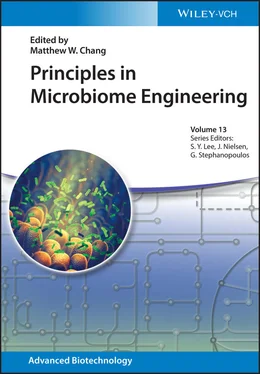Beef‐based protein‐rich diet showed the lower abundance of Bifidobacterium adolescentis and enriched Bacteroides and Clostridia abundance, indicating that meat‐derived protein source can influence the development of the host microbiome [68]. The correlation of gut microbes to protein diet is summarized in Table 1.1.
Table 1.1 Effects of dietary protein on host‐gut microbiota.
|
Microbial diversity |
Bifido bacteria |
Lacto bacilli |
Bacter oides |
Alist ipes |
Bilo phila |
Clost ridia |
Rose buria |
Eubacterium Rectale |
References |
| Animal protein |
↑ |
↑↓ |
|
↑↓ |
↑ |
↑ |
↑ |
↓ |
↑↓ |
[54, 69, 70] |
| Whey protein extract |
↑ |
↑ |
↑ |
|
|
|
↓ |
|
|
[71, 72] |
| Pea protein extract |
↑ |
↑ |
↑ |
|
|
|
|
|
|
[73] |
Source: Singh et al. [68]/Springer Nature/CC BY 4.0.
1.2.1.2 Soluble Saccharides
Soluble saccharides can be divided into simple saccharides (glucose, fructose) and complex polysaccharides (starch), where these sugars provide the energy to the cells. Overconsumption of these sugars is often attributed to various health problems such as obesity, diabetes, cardiovascular disease, liver disease, and tooth decay [74–76]. The presence of high dietary simple sugar content (glucose and fructose) influences the primary metabolism in gut microbial by upregulating sugar transport proteins to increase cellular uptake of the sugar. Similarly, secondary metabolic pathways expressing polysaccharide utilization genes are suppressed in the presence of simple sugars [77]. This phenomenon is commonly observed in Bacteroides thetaiotaomicron that maintain the microbes in their planktonic lifestyle and inhibiting microbial colonization [78]. The suppressed genes include those involved in bacteria biofilms [79] and upregulate genes involved in chemotaxis [80]. The chemotaxis genes include flagella formation that can stimulate the host immune system through interaction with TLR5, as seen on the pathogenesis of the opportunistic pathogen Burkholderia cenocepacia infecting the host [81]. The effects of soluble sugar in the human gut microbiota is summarized in Table 1.2.
Table 1.2 Effects of natural and artificial sugar on gut microbiota.
|
Bifidobacteria |
Bacteroides |
Clostridia |
Lactobacilli |
References |
| Glucose |
↑ |
↓ |
|
|
[82, 83] |
| Fructose |
↑ |
↓ |
|
|
[82, 83] |
| Sucrose |
↑ |
↓ |
|
|
[82, 83] |
| Lactose |
↑ |
↓ |
↓ |
↑ |
[84] |
| Artificial sweeteners |
↓ |
↑ |
↓ |
↓ |
[85] |
Source: Based on Hanuszkiewicz et al. [81].
Dietary fibers are non‐soluble polysaccharides that form the structural component of the plant. These fibers function as prebiotic source, where they form scaffolds for microbial localization and further serve as substrates for microbial fermentation. These fibers include fructans, polydextrose, fructooligosaccharides (FOS), galactooligosaccharides (GOS), xylooligosaccharides (XOS), and arabinooligosaccharides (AOS) [86]. Fiber‐rich diets, such as those of vegetarians and vegans, were found to help alleviate health problems including cardiovascular diseases and cancer [87]. Fiber‐rich diet showed a depletion of Bacteroidetes, Clostridium and Enterococci abundance, and trigger the increase of lactic acid bacteria, Ruminococcus, Eubacterium rectale , and Roseburia abundance. In the presence of dietary fibers, these lactic acid–producing bacteria ferment the fibers to produce short‐chained fatty acids (SCFA) such as acetate, propionate, and butyrate [88]. These SCFA influence the growth of some microbes in the gut, exerting health‐benefiting properties including regulating pathogenic microbial growth [89]. A higher percentage of Bacteroides was found in the intestines of people eating Western diets, while those who ate fruits and beans from a high‐fiber diet found the opposite [90]. The summary of how dietary fiber affects the gut microbiota is shown in Table 1.3.
Table 1.3 Effect of non‐digestible carbohydrates on gut microbiota.
|
Bacterial abundance |
Gene richness |
Lacto bacilli |
Bifido bacteria |
Clost ridia |
Enter ococcus |
Rose buria |
Eubac teria |
Rumin ococcus |
References |
| Fiber/ prebiotics |
↑ |
↑ |
↑ |
↑ |
↓ |
↑↓ |
|
|
|
[70, 91] |
| Resistant starch |
↑ |
↑ |
↑ |
↑ |
|
|
↑ |
↑ |
↑ |
[70, 91, 92] |
Arrow thickness corresponds to the relative number of studies supporting the relationship.
Source: Based on Glick‐Bauer and Yeh [90].
Fat‐rich diets including saturated fats from animal foods negatively affect the gut microbiota, leading to poor metabolization of the nutrient and ultimately leading to obesity. Studies involving murine models showed depletion of Bacteroidetes and Bacillus bifidus abundance and enrichment of Firmicutes and Mollicutes in mice fed with a high‐fat diet [93]. However, such effects on the microbiome are less severe in mice fed with moderate amounts of polyunsaturated fats such as omega‐3, omega‐6, and omega‐9 [94]. Similarly in human studies, a high‐fat diet increases the abundance of anaerobic microbes and Bacteroides [95, 96]. Patients adapting a low‐fat diet showed the increased fecal abundance of Bifidobacterium and decreased proportion of Faecalibacterium prausnitzii [95]. Table 1.4summarizes the effect of dietary fat on the gut microbiota.
Table 1.4 Effect of dietary fat on gut microbiota.
|
Lacticacid bacteria |
Bifido bacteria |
Clostr idiales |
Bacter oides |
Bilo phila |
Faecali bacterium prausnitzii |
Akkermansia muciniphila |
References |
| High fat |
↓ |
|
↑ |
↑ |
|
|
|
[70, 95, 97, 98] |
| Low fat |
|
↑ |
|
|
|
|
|
[95] |
| High saturated fat |
|
|
|
↑ |
↑ |
↑ |
|
[95, 96] |
| High unsaturated fat |
↑ |
↑ |
|
|
|
|
↑ |
[95, 99] |
Lactic acid bacteria include Lactobacillus and Streptococcus .
Читать дальше












